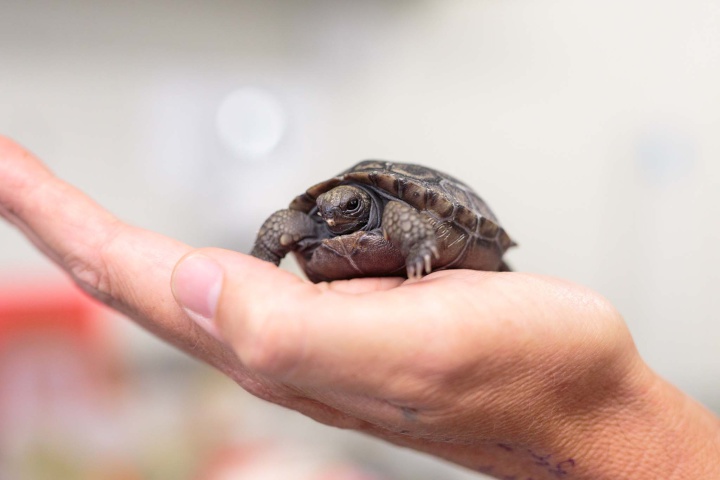Galapagos tortoise hatchling a rare first
Galapagos tortoise hatchling a rare
first

Galapagos tortoise in hand
In a first for New Zealand, Auckland Zoo is celebrating the arrival of a Galapagos tortoise hatchling, and has become only the second zoo in Australasia to breed this species.
The tiny tortoise, which weighed in at just 60 grams when it hatched out of a billiard ball- sized egg on 30 December, is the offspring of first-time parents; mum Chippie (47 years) and dad Smiley (46 years) – still youngsters themselves in Galapagos tortoise years.
As the world’s largest tortoise, if this hatchling is a male, he will grow up to 4000 times in body-mass to reach more than 250kg (quarter of a tonne!), and if female to over 2,500 times (one of the largest changes in body mass from newborn to adult of any vertebrate), and could live for over 150 years!
“These long-lived, slow maturing reptiles are
renowned for taking their time, so we’re delighted that
they’ve finally bred,” says Auckland Zoo’s curator of
Ectotherms and Birds, Richard Gibson.
“The
redevelopment of our tortoise enclosure two years ago
provided us with a fantastic and much larger
climate-controlled indoor area and the capacity to hold two
males separately, enabling us to welcome back our second
male Willy from Ti Point Reptile Park. Willy’s return has
most certainly been a great stimulant to Smiley as a male
competitor, and we hope to see increasing success with
higher rates of fertility among future clutches,” adds
Richard.
When the eggs were laid in the ground by female Chippie over four months ago, the Zoo’s Ectotherms team excavated them for incubation in a controlled environment to ensure their best chance of survival. The sex of this new arrival won’t be known for quite a few years.
Curator Richard, who has observed these tortoises in their native Galapagos Islands and here at Auckland Zoo, says: “These island giants are extraordinary creatures whose story of tragic plunder and decimation, followed by modern understanding of their plight and gradual recovery, has much in common with many New Zealand species”.
“In addition to their exploitation for food and trade by early sailors visiting the islands, introduced mammalian predators including rats and feral pigs, and habitat destruction caused by goats nearly wiped these tortoises out. Thanks to incredible and ongoing efforts to rid the Galapagos Islands of invasive species and successful captive breeding and release programmes – just as we’re doing on islands all around New Zealand to help so many of our own endemic species - the Galapagos giant tortoise species are slowly recovering.”
While Zoo visitors are not yet able to see New Zealand’s first Galapagos tortoise hatchling, in the next few weeks the Zoo’s Ectotherms team will be looking to move it from its off-display facility and into a viewable enclosure at the Zoo’s Galapagos tortoise house.
You can
watch our hatchlings journey so far here:
https://www.youtube.com/watch?v=o7yRkHcbrHc
Galapagos
tortoise facts
• The Galapagos tortoise is the
world’s largest tortoise; males can reach 250kg and
females up to 150kg
• This tortoise’s ancestors
almost certainly arrived in the Galapagos by floating across
the Pacific from South America. It was named by Spanish
explorers who discovered the Galapagos Islands in the
16thcentury; galápago is an old Spanish word for
tortoise
• Today there are 11 different species of
giant tortoises remaining in the Galapagos; down from 15
when Darwin first arrived, and a total estimated population
of approximately 15,000
• Hunted for food by pirates,
whalers and merchantmen from 17th – 19th centuries, more
than 100,000 tortoises are estimated to have been
harvested
• Highly threatened, the Galapagos tortoises
have been protected by the Ecuadorian government since 1970.
Captive breeding and restoration efforts by the Charles
Darwin Research Station are having some positive
effects
• Breeding: Sexual maturity of Galapagos
tortoises is between 20 – 30 years, and these reptiles can
continue growing even when they are 40 – 50 years
old!
• Females use their hind legs to dig a
flask-shaped hole about half a metre deep, and lay up to 16
billiard-ball sized eggs. They will urinate in the nest to
soften the soil and increase its humidity while laying. Once
laid, they fill in the hole and walk away. Incubation range
is 3 – 8 months.
Galapagos tortoises at Auckland
Zoo
• Auckland Zoo has four adult Galapagos tortoises;
males Smiley and Willy (both 46 years) and females Chippie
(47) and Snapper (48), all of whom were hatched at Honolulu
Zoo and came to Auckland Zoo in 1983.
• The arrival of
Auckland Zoo’s recent hatchling (following a 4-month
incubation) to first-time parents male Smiley and female
Chippie marks the first breeding of Galapagos tortoises in
New Zealand
• Following Taronga/Western Plains Zoo in
Australia, Auckland Zoo is only the 2nd zoo in Australasia
to breed Galapagos
tortoises.
ends


 Athletics New Zealand: Funding Boost Propels Athletics NZ Toward LA 2028 Success
Athletics New Zealand: Funding Boost Propels Athletics NZ Toward LA 2028 Success Te Whatu Ora Health New Zealand: Large Numbers Of RSE Workers Get Immunised To Protect Pacific Island Nations
Te Whatu Ora Health New Zealand: Large Numbers Of RSE Workers Get Immunised To Protect Pacific Island Nations Eden Park: International Venue Of The Year And Ranked 25th In Pollstar’s Top 100 Worldwide Stadiums For Concerts
Eden Park: International Venue Of The Year And Ranked 25th In Pollstar’s Top 100 Worldwide Stadiums For Concerts Early Childhood New Zealand: Sector Responds To Regulatory Review Of Early Childhood Education (ECE)
Early Childhood New Zealand: Sector Responds To Regulatory Review Of Early Childhood Education (ECE) Paralympics NZ: Four Further Paralympians Presented With Official Numbered Pins
Paralympics NZ: Four Further Paralympians Presented With Official Numbered Pins